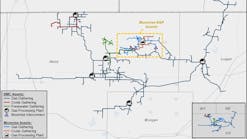ConocoPhillips reports higher 2013 earnings, expects higher production in 2014
ConocoPhillips reported full-year earnings of $9.2 billion in 2013, an increase from the $8.4 billion totaled in 2012, which included $1.2 billion from downstream operations before the separation of Phillips 66 on Apr. 30.
Adjusted full-year earnings for 2013 were $7.1 billion compared with full-year 2012 adjusted earnings of $6.7 billion.
Fourth-quarter earnings reflected the upward trend, as the company tallied $2.5 billion last year, up from $1.4 billion in fourth-quarter 2012.
The company closed asset sales for proceeds of about $7 billion in fourth-quarter 2013, including the sale of interest in Kashagan to Kazakhstan state oil company KazMunayGas for $5.4 billion and the Algeria business to Indonesian state oil company Pertamina for $1.75 billion (OGJ Online, Oct. 21, 2013; Nov. 27, 2013).
Adjusted fourth-quarter earnings in 2013, excluding discontinued operations as a result of a gain from the sale of the Algeria business, were $1.7 billion, compared with fourth-quarter 2012 adjusted earnings of $1.8 billion.
ConocoPhillips expects 3-5% production growth this year. The company’s 2014 full-year production outlook, excluding Libya, is unchanged at 1.55 million boe/d. First-quarter 2014 production from continuing operations, also excluding Libya, is expected at 1.49-1.53 million boe/d.
North America, Latin America
Fourth-quarter production in 2013 in the Lower 48 and Latin America was 497,000 boe/d, an increase of 22,000 boe/d compared with the same period in 2012. During the quarter, production across several areas within the Lower 48 was impacted by weather-related downtime.
Growth continued from liquids-rich plays in the Eagle Ford, Bakken, and Permian, which delivered 218,000 boe/d for the quarter, a 31% increase compared with fourth-quarter 2012. Eagle Ford and Bakken reached a peak daily rate of 141,000 boe/d and 43,000 boe/d, respectively, in fourth-quarter 2013.
Fourth-quarter North American activity remained focused on drilling in the Niobrara and Permian basin in the Lower 48, as well as the Montney, Duvernay, and Canol plays in Canada.
Production for the quarter in Alaska was 205,000 boe/d, a 17,000 boe/d decrease compared with fourth-quarter 2012, primarily reflecting normal field decline.
Following the passing of the More Alaska Production Act, ConocoPhillips is increasing development activity with the addition of a second rig brought on at Kuparuk in January. During the fourth quarter, construction continued at the Alpine West CD5 Project with production expected to begin in late 2015.
ConocoPhillips in April 2013 cancelled plans to drill in the Chukchi Sea citing federal regulatory uncertainty (OGJ Online, Apr. 11, 2013).
Quarterly production in Canada was 276,000 boe/d, a decrease of 5,000 boe/d compared with the same period in 2012. This decrease was primarily due to normal field decline in western Canada conventional assets and a major turnaround at Foster Creek completed in early October.
This was partly offset by a production increase from Christina Lake Phases D and E. Strong performance at Christina Lake drove increased bitumen production of 119,000 boe/d, up 12% compared with fourth-quarter 2012. Additional growth is expected at FCCL as production from Christina Lake Phase E ramps to full capacity and Foster Creek Phase F starts production, expected in third-quarter 2014.
Production in the Lower 48 and Canada continues to shift from natural gas to liquids. For the quarter, total liquids production in these two areas increased by 10% compared with the same period in 2012, resulting in the liquids percentage of production increasing to 52 % from 48%.
In the deepwater Gulf of Mexico, ConocoPhillips drilled an oil discovery at the Gila prospect, appraisal continues at Tiber and Coronado, and exploration drilling is ongoing at the Deep Nansen wildcat.
Europe, Asia, Middle East, Africa
Fourth-quarter production in 2013 in Europe was 197,000 boe/d, a decrease of 19,000 boe/d compared with the same period in 2012. The decrease was primarily due to normal field decline, partly offset by improved well performance in Norway.
Also during the quarter, production began from the Ekofisk South platform in October and Jasmine field in November (OGJ Online, Oct. 28, 2013; Nov. 20, 2013). At Jasmine, production continues to ramp up and is expected to reach full rate late in first-quarter this year. Major project activities continue at Britannia Long-Term Compression and Eldfisk II in preparation for the start of production in third-quarter 2014 and early 2015, respectively.
Quarterly production in the Asia Pacific and Middle East region was 292,000 boe/d, a decrease of 30,000 boe/d compared with fourth-quarter 2012, primarily due to field decline and the fourth-quarter 2013 Qatargas 3 turnaround. This was partly offset by growth in China from new wells online.
In Malaysia, offshore installation is complete and commissioning activities continue on the floating production system (FPS) at the Gumusut field, with oil production expected from the FPS in second-quarter 2014.
At Siakap North-Petai, oil production is expected to start in first-quarter 2014. Construction continues at Kebabangan with sail away of the topsides planned for second-quarter 2014. Progress also continues at APLNG as completion reached 60%.
The company in Indonesia completed an acquisition to obtain operatorship and 100% interest in the Palangkaraya PSC. Offshore Australia, appraisal drilling continues at Poseidon. Preparations are underway for additional 2014 deepwater drilling programs in Angola, Australia, Gulf of Mexico, and Senegal.
In other areas around the world, production from continuing operations was 6,000 boe/d in the fourth quarter, a decrease of 44,000 boe/d compared with the same period in 2012, reflecting Libya curtailment.
Libya production remains shut-in as a result of the Es Sider Terminal shutdown. During the fourth quarter, the company sold its interests in Kashagan and the Algeria business. Operations related to Kashagan, Algeria, and Nigeria have been reported as discontinued operations.
Preliminary yearend 2013 proved reserves are 8.9 billion boe, 3% higher than 2012. Proved organic reserve additions are expected at 1.1 billion boe, an organic reserve replacement ratio of 179% of 2013 production.

